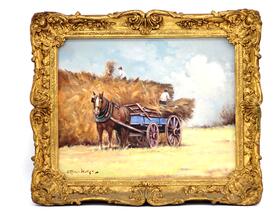Hidden in Plain Sight- Museum Type Objects Found in The Everyday Home
Hidden in Plain Sight- Museum Type Objects Found in The Everyday Home
by Rosei Frost
Our national love of antiques television programmes come from our fascination with the discovery of hidden treasures or amazing car boot finds. Our next Special Sale on the 22nd February has several such examples.
This month we had the privilege of working with objects belonging to local “hero” David Turner (also known as Baron David Ainger-Turner). He is famed for restoring Wymondham train station’s derelict buildings and transforming them into a restaurant which still operates today. After retiring he went on to continue improving his local community by displaying parish documents that dated back to the 16th century to raise funds to repair the local church. “If I can offer to help to raise money then I’m always willing to do so.”
An eclectic mix of items illustrate his life from Stephen Walker paintings to a fold out gentleman’s drinks table complete with cigar box. A more unusual antique comes in the form of his leather four-fold screen.
Room dividers have a long history and like many things in life, (today and historically), they originated in China. Their popularity in Europe spread and they became common-place items in large houses helping to provide privacy in bedrooms and for use as draught excluders or room dividers in larger entertaining rooms.
David Turner’s example has been created using fragments from 18thC European leather wallpaper. This luxurious and opulent form of decoration was not only costly but time consuming to produce. Embossed leather was glued with silver leaf then coated with yellow varnish to resemble gold leaf. David’s screen was likely produced in the 19thc with salvaged pieces of leather wallpaper, a testament to restoration and preservation. It provides a rare opportunity to purchase a portable piece of interior decorating history! Surviving examples of leather wallpaper can be seen at the National Trust’s Oxburgh Hall in Norfolk.
The Arts and Crafts movement would have highly approved of the salvaging of wallpaper with their creations being a reaction against the industrial revolution and factory produced objects. Their ideals were grounded in handicrafts and a revival of lost crafts. Stylistically their items can usually be distinguished by tell tale signs that they were displaying how an object had been created, rivets on display, hand beaten surfaces, all were proud marks of hand crafting. The delicate patination of hand beaten silver can be seen in the pot and cover designed and made by Omar Ramsden and Alwyn Carr consigned to the auction on the 22nd. Each side has been decorated with a grotesque mask paying homage to the trend for gothic revivalism within the Arts and Crafts movement. Examples of his work can be found in the Fitzwilliam Museum, Cambridge.
Samplers are not as revolutionary as pieces made by the Arts and Crafts movement, but they are equally as historically important. Produced as a display of the makers skills and often exhibiting complex pictures they are fascinating as a collector’s piece because each one is unique. Our sale features a large example depicting ‘Newlands Park’ a large imposing country house and a large variety of decoration ranging from Adam and Eve to peacocks, deer and other animals. Our favourite feature appears on the lower left-hand border in the form of ‘Bob the dog’. This could have been used as a dual meaning as ‘bob’ often refers to two shillings and the header of the sampler reads “Blessed are they that remember the poor”. No museum or stately home is complete without a sampler. A fun activity for children to carry out next time you are visiting a stately home or museum is seek out their sampler collection and see if they can identify all the different stitched images, it is much harder than it looks!
